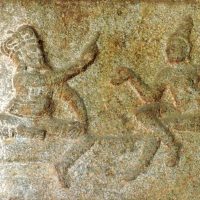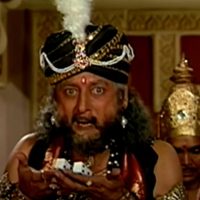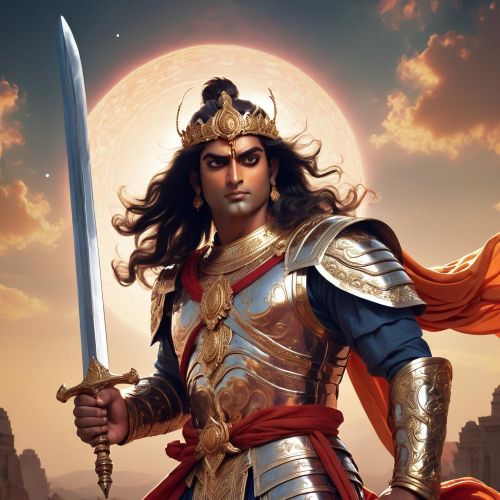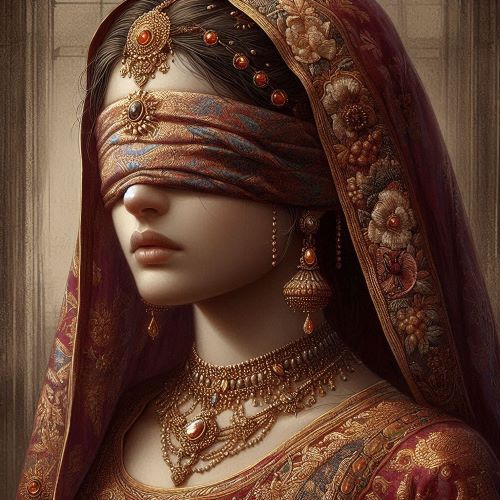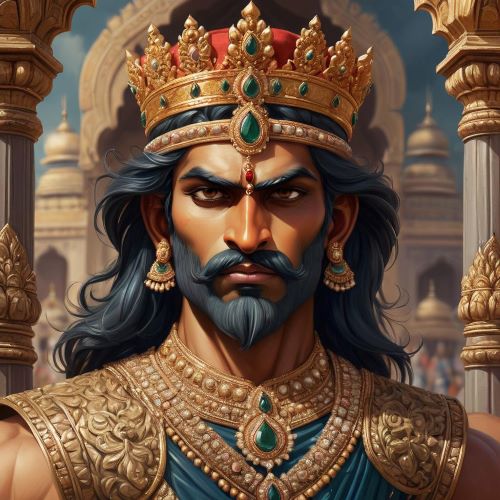Shakuni : The Scheming Strategist
Listen
At a glance
| Description | |
|---|---|
| Origin | Indian Mythology |
| Classification | Mortals |
| Family Members | Subala (Father), Gandhari (Sister), Uluka (Son) |
| Region | India |
| Associated With | Gambling, Strategy |
Shakuni
Introduction
Shakuni, the prince of Gandhara and maternal uncle of the Kauravas, remains one of the most fascinating and controversial figures in the Mahabharata. Known for his unmatched cunning, sharp intellect, and gift for manipulation, he is often portrayed as the mind behind the downfall of the Kuru dynasty. While other characters fought with weapons, Shakuni fought with words, dice, and strategy. His influence on the events that led to the Kurukshetra War reveals not just the destructive potential of vengeance but also the brilliance of a mind that could outwit even the wisest. Shakuni represents the shadow side of intelligence—proof that brilliance without ethics can bring even the mightiest kingdoms to ruin.
Physical Traits
Though the Mahabharata itself offers limited details about Shakuni’s appearance, later retellings and artistic depictions paint a vivid picture. Shakuni is often portrayed as a tall, slender man with keen, penetrating eyes that reflect his calculating nature. His face, sharp and expressive, conveys both arrogance and intelligence. Many interpretations describe him as walking with a limp—a result, according to folklore, of being imprisoned and starved by the Kauravas’ ancestors, leaving him physically weakened but mentally sharper than ever. This physical imperfection came to symbolize his internal wounds—an outward reminder of the pain and vengeance that fueled his actions.
In iconography and television portrayals, Shakuni is often seen holding a box of dice, the instrument of his most notorious manipulation. His composed demeanor, refined speech, and deliberate movements reflected the Gandharan tradition of diplomacy, concealing the depth of his resentment beneath a façade of charm.
Family
Shakuni was born into the royal family of Gandhara, an ancient kingdom located in what is now modern-day Pakistan. His father, King Subala, was a wise ruler known for his diplomatic acumen, and his mother was Queen Vasumathi. Shakuni’s sister, Gandhari, was married to Dhritarashtra, the blind prince of Hastinapura. This alliance linked Gandhara with the powerful Kuru dynasty but also sowed the seeds of tragedy.
According to certain traditions, Gandhari was forced into this marriage, and in an act of devotion, she chose to blindfold herself for life so she could share her husband’s blindness. Shakuni, furious that his beloved sister was condemned to a life of darkness, vowed revenge against the Kuru family. His grudge deepened when legends say the Kurus imprisoned and starved his family, leaving him as the lone survivor. This trauma became the foundation of his lifelong mission—to destroy the dynasty from within, not through war, but through intellect and deception.
Shakuni’s own son, Uluka, carried his father’s cunning and served as Duryodhana’s messenger during the Kurukshetra War. Both father and son perished in the conflict, marking the tragic end of the Gandhara line—a grim reflection of how vengeance ultimately consumed everything Shakuni held dear.
Other names
Shakuni was known by many names across different texts and regions, each capturing a facet of his identity. He was often called Saubala, meaning “son of Subala,” signifying his royal heritage. Gandhararaja, or “King of Gandhara,” reflects his sovereignty and pride in his lineage. The epithet Kitava, meaning “gambler,” immortalized his mastery over the game of dice that changed the fate of kingdoms.
Interestingly, the Sanskrit word Śakuni translates to “bird” or “vulture,” a name symbolic of his predatory intelligence—circling patiently, waiting for the right moment to strike. In some traditions, he is even associated with Dvapara Yuga, the age of deceit and declining virtue, embodying the moral decay that defined the era. Each name encapsulates a layer of his personality—noble by birth, strategic by nature, and destructive by choice.
Powers and Abilities
Shakuni’s greatest weapon was not his physical strength but his mind. His brilliance lay in his ability to read human emotions and exploit them to his advantage. He understood ambition, pride, and weakness better than anyone in the Mahabharata. As a master strategist, he used these insights to manipulate Duryodhana, turning him into a pawn in his larger scheme of vengeance.
His legendary skill in gambling became his signature ability. The most famous tale speaks of dice carved from the bones of his father, Subala, which always obeyed his command. Whether taken literally or symbolically, this story reflects how Shakuni turned ancestral suffering into the very tool that brought down the Kuru dynasty. During the infamous dice game, he outwitted Yudhishthira twice, leading to the Pandavas losing their kingdom, their freedom, and Draupadi’s dignity.
Beyond dice and deceit, Shakuni possessed extraordinary political foresight. He was the unseen architect behind numerous plots, including the attempt to burn the Pandavas alive in the House of Wax. His words could ignite conflict as effectively as weapons. While some viewed him as demonic, others saw him as a tragic genius—a man whose intellect, unrestrained by dharma, became his own undoing.
Modern Day Influence
In the modern era, Shakuni has evolved from a one-dimensional villain to a complex, psychologically rich character. His legacy has been reinterpreted across literature, theater, television, and academia. Popular adaptations like Mahabharat (1988) and Suryaputra Karn have portrayed him as charismatic yet ruthless, a political genius driven by personal trauma rather than inherent evil. His scheming smile and unforgettable dialogues have made him one of Indian mythology’s most iconic antagonists.
In political discourse, “Shakuni” has become a metaphor for behind-the-scenes manipulators and strategic masterminds—those who pull the strings while others take the fall. His character serves as a timeless lesson in leadership and ethics, reminding us that intelligence without morality leads to destruction. Business schools and management studies sometimes reference Shakuni as an archetype of unethical strategy—a case study in how cunning and persuasion can be weaponized.
Writers and playwrights have also sought to humanize him. In Poile Sengupta’s Thus Spake Shoorpanakha, So Said Shakuni, his story is retold through a more empathetic lens, exploring how pain and injustice shaped his choices. Psychologically, Shakuni embodies the darker aspects of human intelligence—the desire to control, to avenge, and to outthink destiny itself.
Even in digital culture, Shakuni’s influence persists. Memes, political commentary, and popular discussions frequently use his name as shorthand for manipulation or clever plotting. Yet, despite centuries of vilification, his story continues to fascinate because it forces us to confront uncomfortable truths: that intelligence can be both a gift and a curse, and that those who play the game too well often lose more than they win.
Related Images
Source
Chakraborty, P. (2021). Shakuni of Epic Mahabharata: A Factual Study. Indica Today. https://www.indica.today/long-reads/shakuni-epic-mahabharata-factual-study/
DollsofIndia. (2015). Shakuni: A Villain or a Victim of Circumstance? https://www.dollsofindia.com/library/shakuni/
Glorious Hinduism. (2019). Shakuni: The Master Conspirator. https://glorioushinduism.com/2019/12/11/shakuni/
Mahabharata Wiki. (2024). Shakuni. https://mahabharata.fandom.com/wiki/Shakuni
Hindu Culture Hub. (2025). Shakuni: The Puppeteer Behind the Thorns of Mahabharata. https://hinduculturehub.com/texts-scriptures/mahabharata/shakuni/
Villains Wiki. (2024). Shakuni. https://villains.fandom.com/wiki/Shakuni
The Knowledge Nexus. (2024). Leadership and Emotional Intelligence Lessons from Shakuni. https://theknowledgenexus.in/leadership-and-emotional-intelligence-lessons-from-shakuni-for-transforming-negatives-into-positives/
Wikipedia. (2024). Shakuni. https://en.wikipedia.org/wiki/Shakuni
Bhattacharya, N. (2004). Indian Epic Characters: Myth and Meaning. New Delhi: Rupa Publications.
Doniger, W. (2009). The Hindus: An Alternative History. New York: Penguin Books.
Hiltebeitel, A. (2001). Rethinking the Mahabharata: A Reader’s Guide to the Education of the Dharma King. University of Chicago Press.
Pattanaik, D. (2010). Jaya: An Illustrated Retelling of the Mahabharata. New Delhi: Penguin India.
Frequently Asked Questions
What is lorem Ipsum?
I am text block. Click edit button to change this text. Lorem ipsum dolor sit amet, consectetur adipiscing elit. Ut elit tellus, luctus nec ullamcorper mattis, pulvinar dapibus leo.
What is lorem Ipsum?
I am text block. Click edit button to change this text. Lorem ipsum dolor sit amet, consectetur adipiscing elit. Ut elit tellus, luctus nec ullamcorper mattis, pulvinar dapibus leo.
What is lorem Ipsum?
I am text block. Click edit button to change this text. Lorem ipsum dolor sit amet, consectetur adipiscing elit. Ut elit tellus, luctus nec ullamcorper mattis, pulvinar dapibus leo.
What is lorem Ipsum?
I am text block. Click edit button to change this text. Lorem ipsum dolor sit amet, consectetur adipiscing elit. Ut elit tellus, luctus nec ullamcorper mattis, pulvinar dapibus leo.
What is lorem Ipsum?
I am text block. Click edit button to change this text. Lorem ipsum dolor sit amet, consectetur adipiscing elit. Ut elit tellus, luctus nec ullamcorper mattis, pulvinar dapibus leo.




